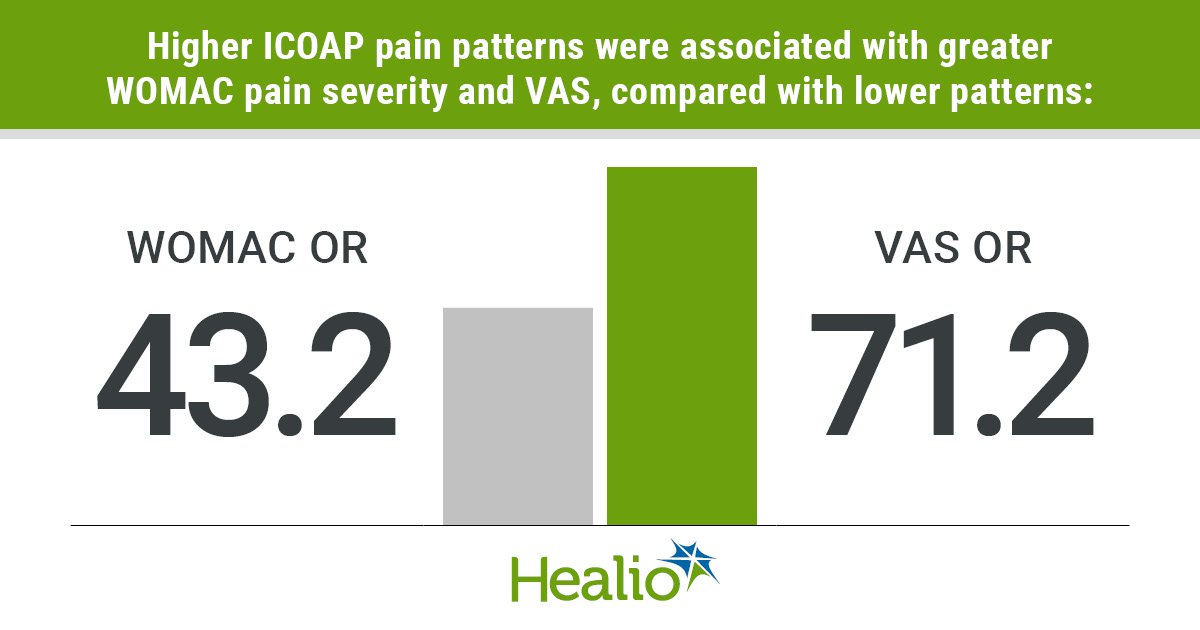Knee pain pattern linked to radiographic OA disease stage, duration

Knee pain patterns were associated with radiographic osteoarthritis disease stage and duration, in addition to pain severity, according to findings published in Arthritis Care & Research.
“We know that with knee osteoarthritis there can be a worsening in the frequency and severity of pain as the disease progresses,” Lisa C. Carlesso, PT, PhD, of McMaster University, told Healio Rheumatology. “Previous studies have suggested that this progression occurs with changing patterns of pain from being intermittent in nature, to more constant and finally to a mix of constant with intermittent pain.”
“Our study examined whether these three described pain patterns are associated with pain severity, severity of disease on x-ray and duration of disease,” she added. “This was important step to validate the patterns, as it presents a new way to understand symptomatic disease progression.”
To analyze the link between knee pain patterns to radiographic OA severity and duration, as well as pain severity, Carlesso and colleagues examined data from the Multicenter Osteoarthritis (MOST) Study. According to the researchers, MOST is a NIH-funded longitudinal cohort of community-dwelling adults aged 50 to 79 years who had or were at risk for developing knee OA at baseline. Participants were recruited from Birmingham, Alabama, and Iowa City, Iowa. For this analysis, Carlesso and colleagues analyzed 2,322 participants who attended the 60-month visit, as that was the first time Intermittent and Constant OA Pain (ICOAP) data were recorded.

Investigators organized ICOAP scores into one of four groups — no intermittent or constant pain, intermittent pain only, constant pain only, and a combination of constant and intermittent pain. They assessed pain severity using the WOMAC pain subscale and the Visual Analog Scale (VAS).
Radiographic knee OA severity was defined as a Kellgren Lawrence grade of 2 or greater, and duration was characterized according to the clinic visit where radiographic disease was first recorded. They conducted analyses using regression models with generalized estimating equations.
According to Carlesso and colleagues, higher ICOAP pain patterns — defined as a mix of constant and intermittent pain — were associated with greater WOMAC pain severity, compared with those without either pain pattern (OR = 43.2; 95% CI, 26.461.3). Results were similar for VAS (OR = 71.2; 95% CI, 45.7110.9). Additionally, participants with more severe (OR = 3.7; 95% CI, 3.14.6) and longer-duration (OR = 2.9; 95% CI, 2.53.5) forms of radiographic OA were more likely to demonstrated a mix of constant and intermittent pain, compared with those without either pain.
“Our findings highlight the need to take a broader approach when trying to understand pain and its mechanisms that likely differ by stage of disease,” Carlesso said. “Importantly, these knee pain patterns appear to likely be more useful than pain severity alone for understanding symptomatic disease progression.”
She added, “We used the ICOAP questionnaire in our study to determine the presence of the different pain patterns. Our results suggest that clinicians may be able to use the ICOAP as a tool to effectively track knee OA progression, and using this questionnaire may potentially help diminish differences seen in patients reported pain severity and their disease status on X-ray. Again, pain severity alone does not provide a full picture of a person’s disease status.” – by Jason Laday
Disclosures: The researchers report no relevant financial disclosures.
